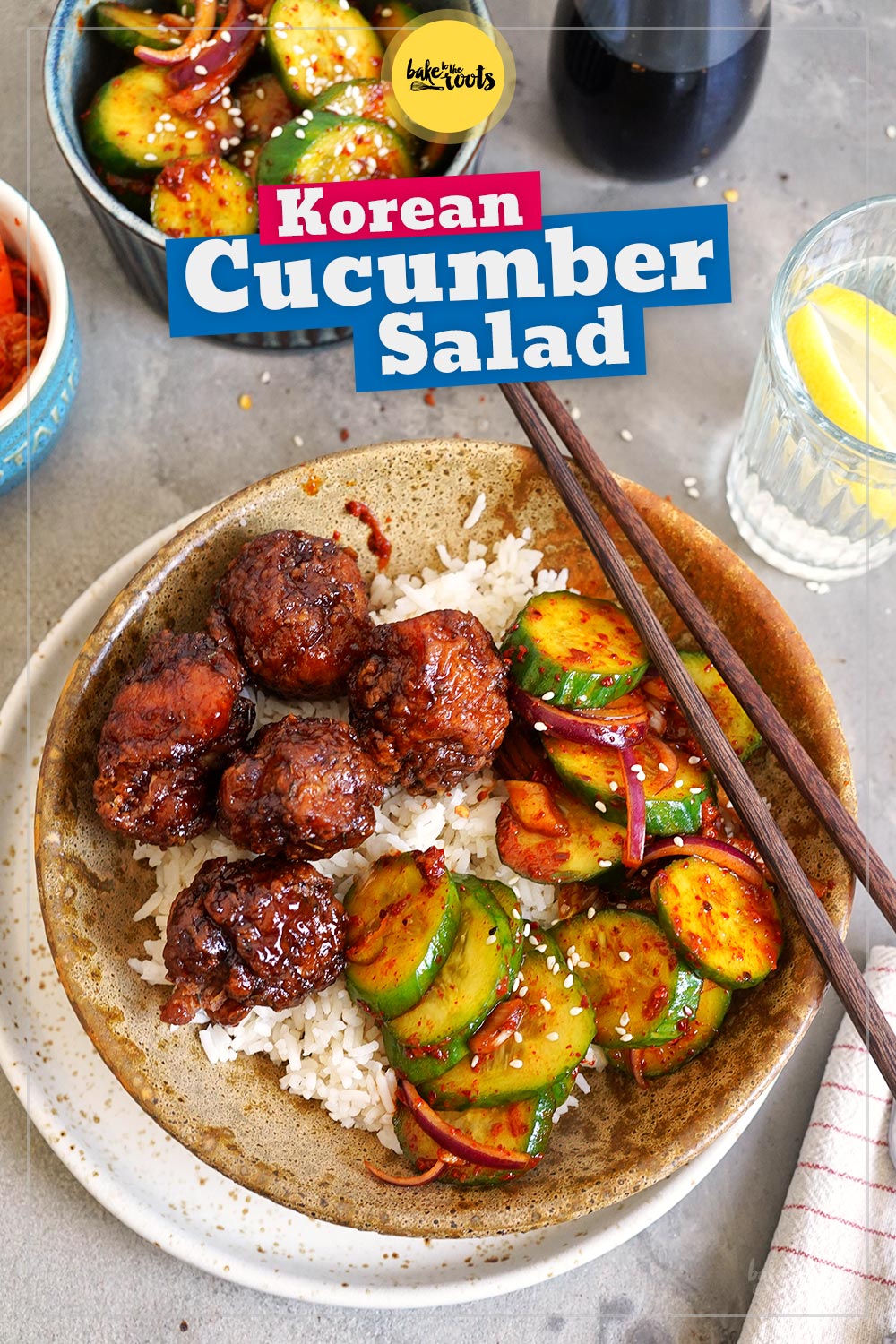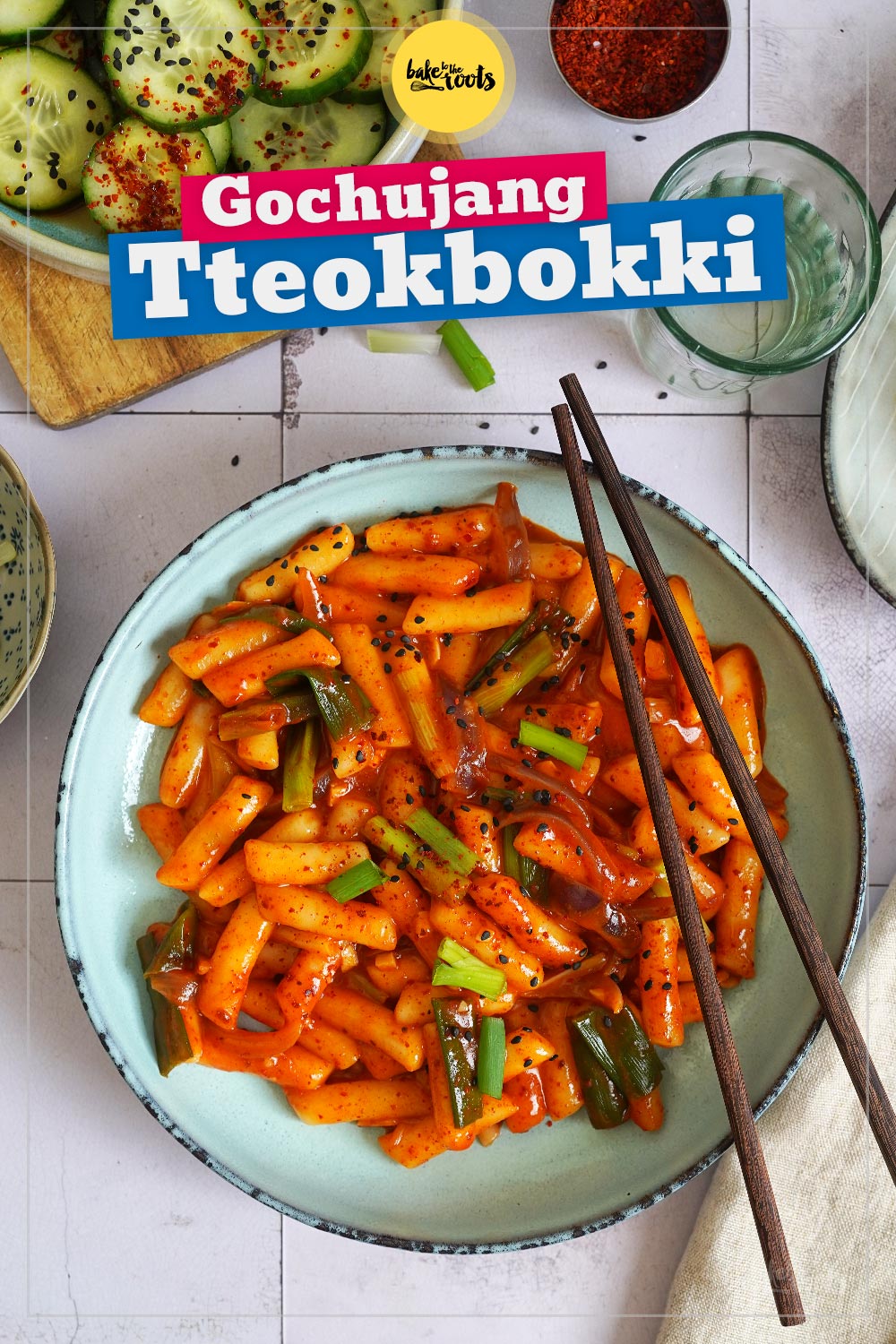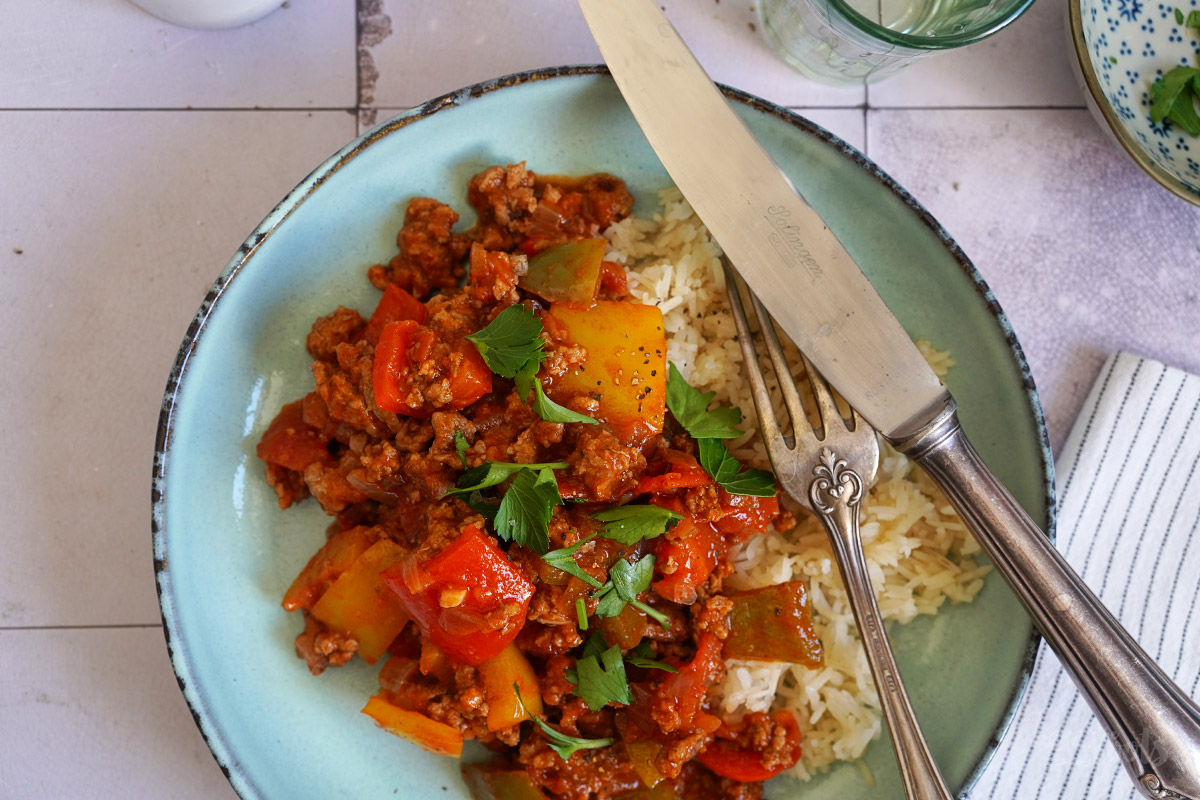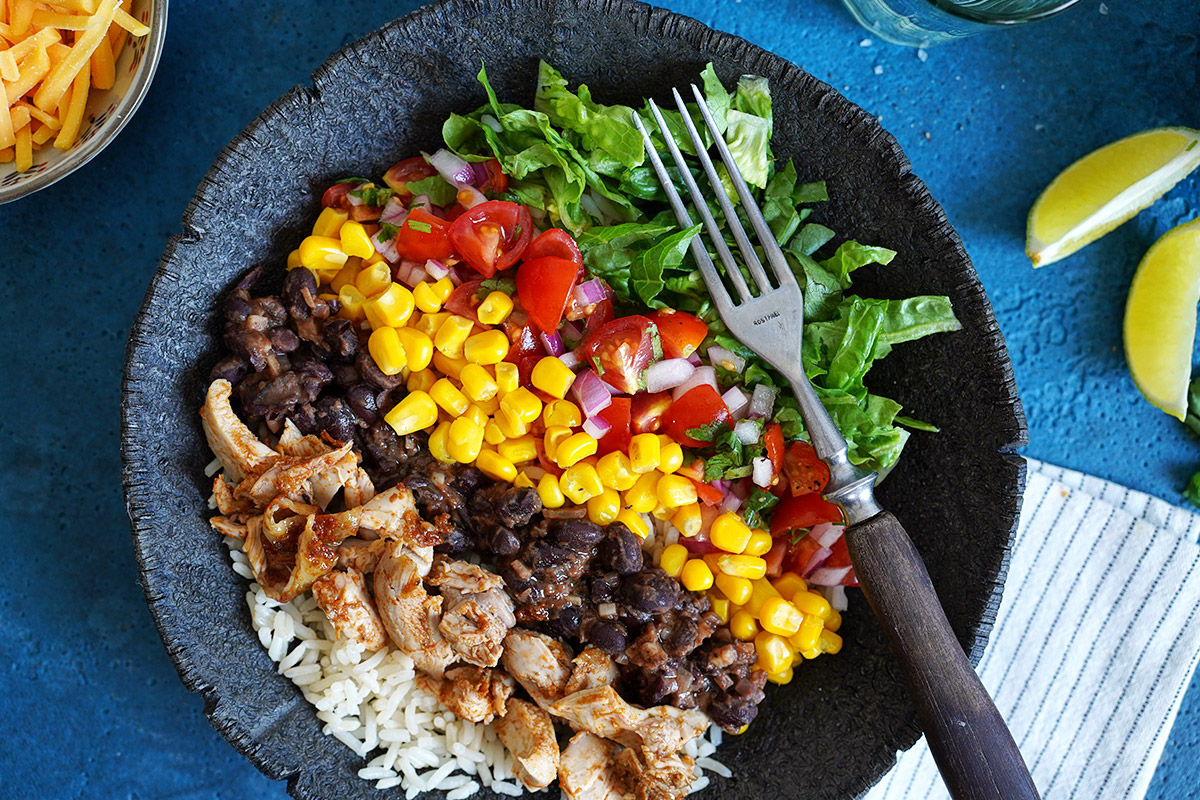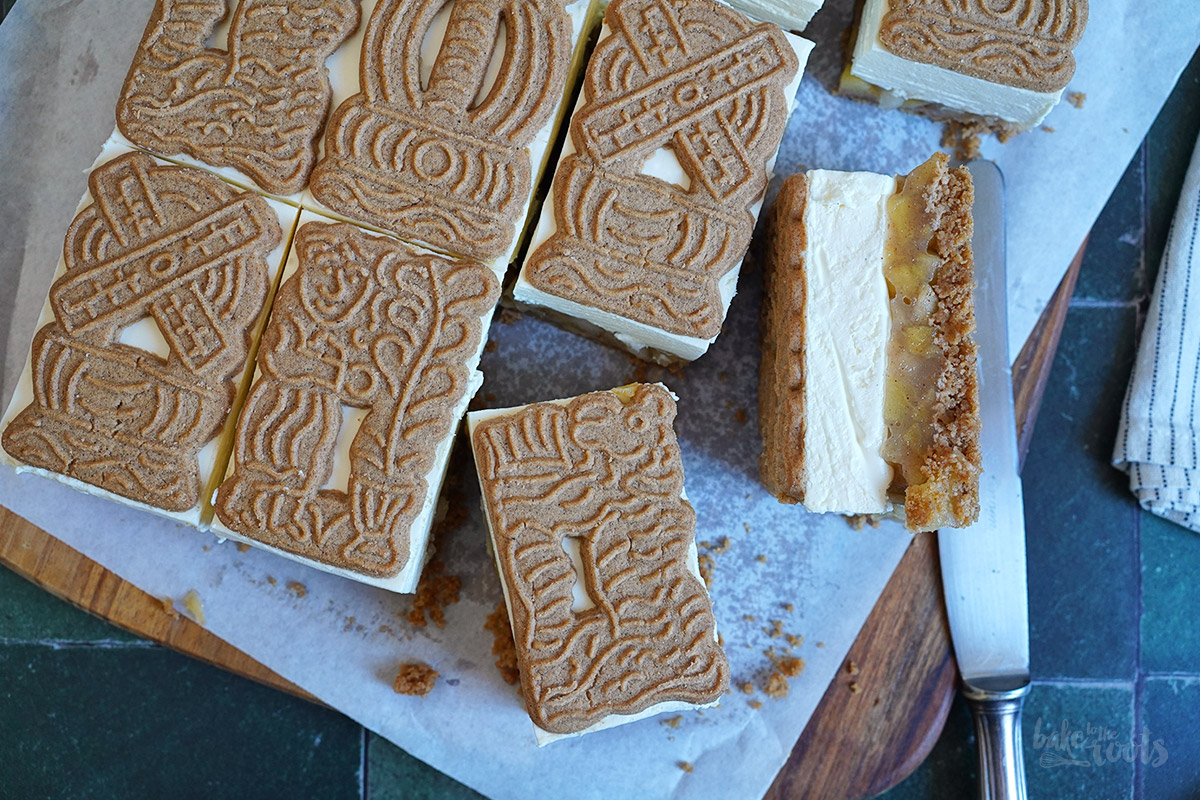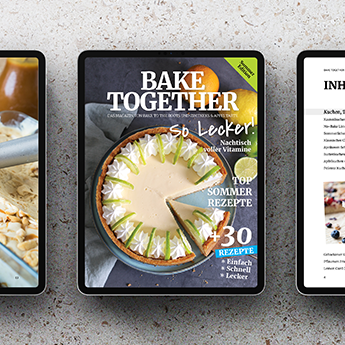I assume not everyone is familiar with Korean rice cakes. Let’s be clear – they’re not sweet pastries. Rice cakes are something more similar to gnocchi. That’s why rice cakes are used for cooking and not for baking. For Korean Tteokbokki with Gochujang, for example. A spicy dish with a very nice, intense orange-red color. Just the way we like Asian food! We love spicy food… it does not necessarily have to be orange or red. ;P
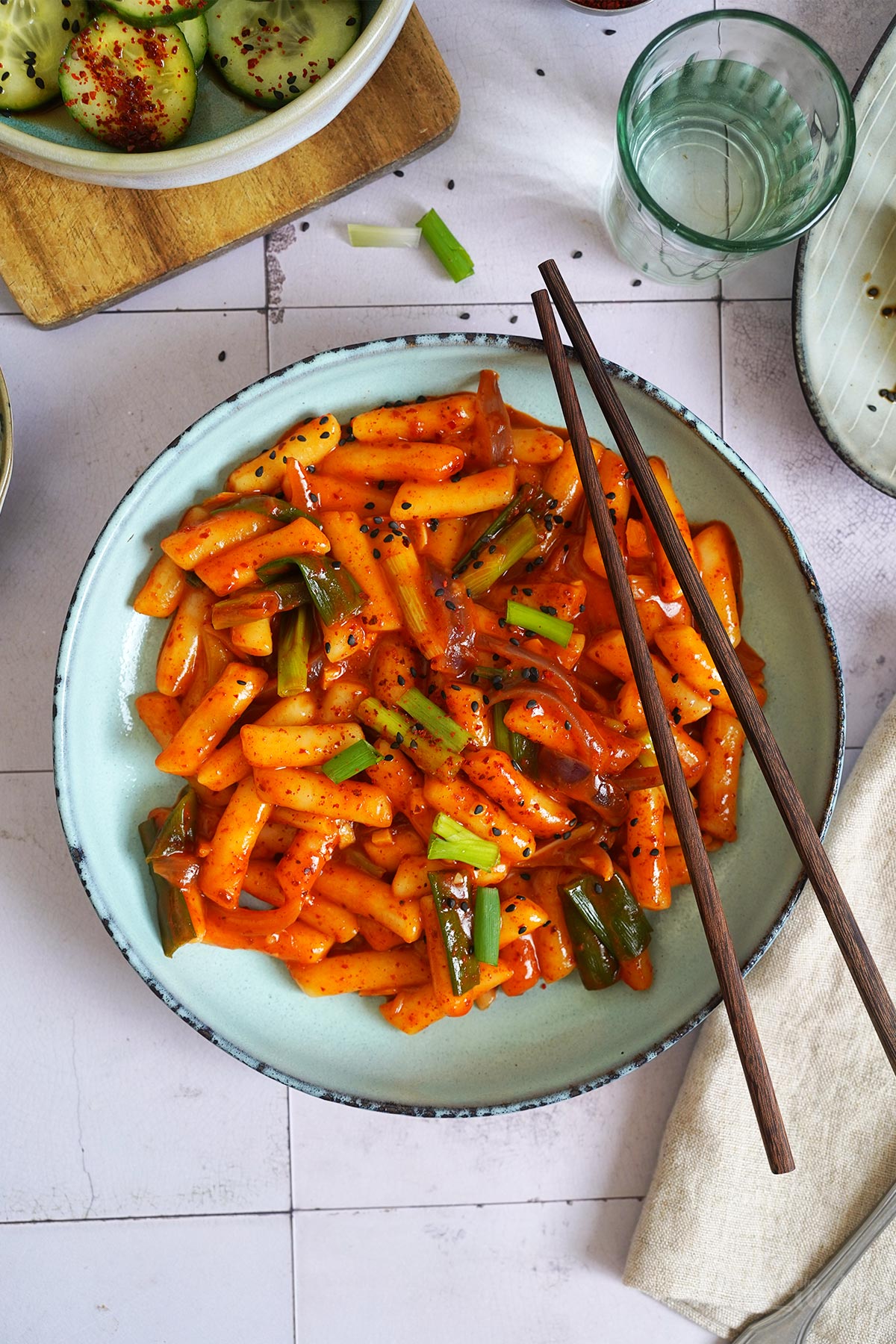
The name Tteokbokki probably doesn’t roll off the tongue easily for most Europeans (or anyone in English-speaking countries). Although… once you get the hang of it, it’s actually quite simple. The spelling is just a bit confusing. The pronunciation of Tteokbokki can be described phonetically as »tok-bok-ki«, where the »t« in »tok« sounds like a blend of »d« and »th« (the tongue rests on the roof of the mouth here), followed by »bok« and »ki«, each pronounced short. Tteokbokki. got it? ;)
If Tteokbokki is still a bit too complicated for you to pronounce, you can always opt for »rice cakes«. So, in theory, you could say »Korean rice cakes with Gochujang« and everyone will probably know what you want. The word Gochujang (goo-tschoo-dschang) probably isn’t in everyone’s vocabulary, either – but most people pronounce it intuitively correct. Except maybe Americans, who like to add a »yeeeang« at the end. ;P
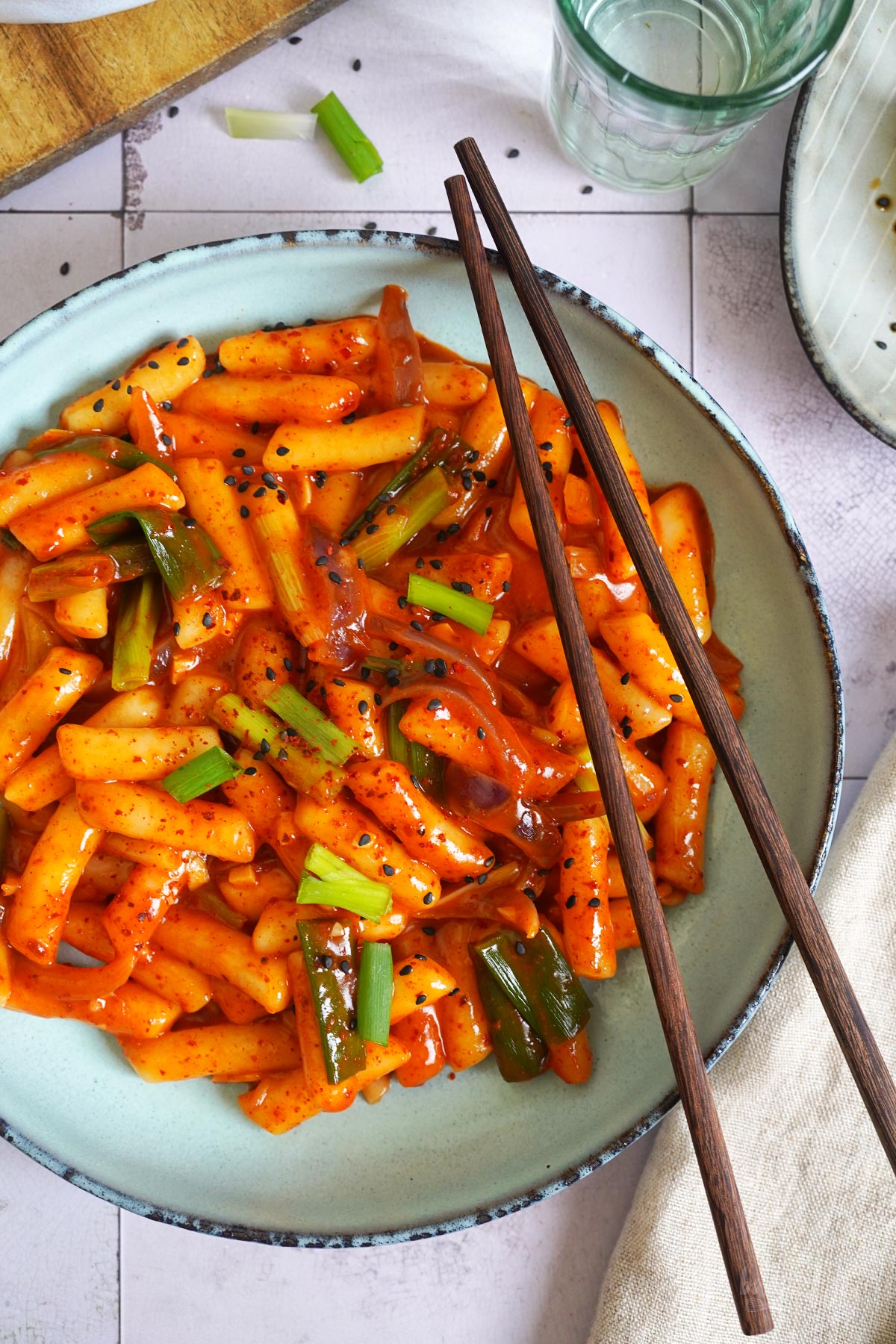
Just kidding. Pronunciation aside, we love the rice cakes with the hot Gochujang sauce. It should perhaps be mentioned, however, that the sauce we prepare here, is really hot. Three chili peppers hot. You have to like that, I know. Stuff can be difficult for some people. You can use less spices, of course, if you don’t tolerate the heat quite that well. You just have to use the Gochujang (the hot chili paste) and Gochugaru (ground chili peppers) a little more sparingly. However, the original Korean dish is intended to be quite spicy. Grit your teeth and get through it, I’d say. After 20 minutes, the pain usually dies down a bit… ;P
Again – just kidding. Or not? The sauce is really hot. You can always skip the chili paste or the ground chili peppers and use a little tomato paste and some more soy sauce instead. That should tone down the spiciness of the dish a lot. Adding a bit more sugar is always a good way to get rid of some heat, but we prefer to use less spices when required and not dull the spices down with sugar. The rice cakes add already a decent amount of carbs to the dish – no need to add more with added sugar, right?
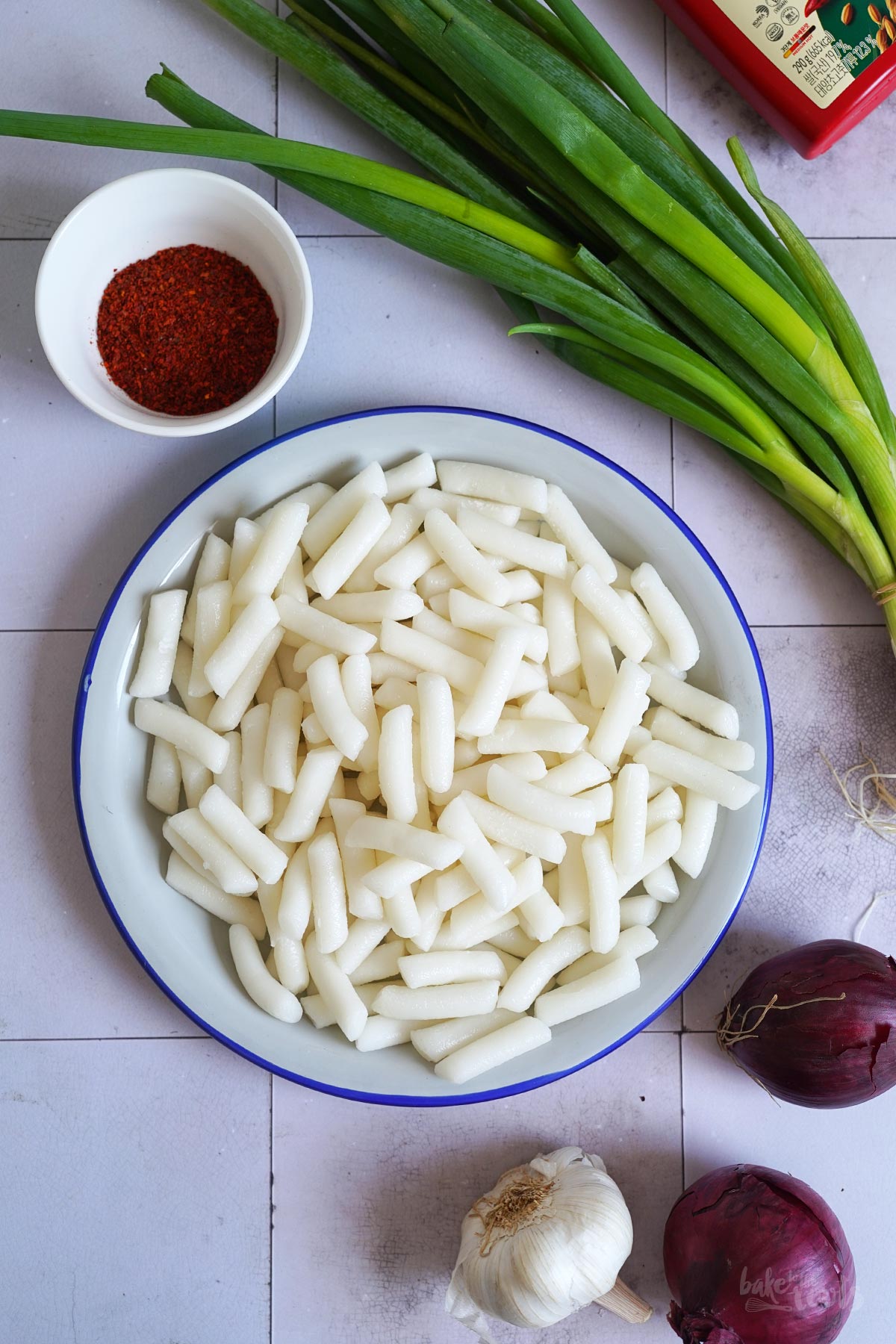
Korean rice cakes are available in more than version. We used cylindrical »sticks« here – but you can also find them as flat discs in Asian supermarkets. The flat discs are often used in soups, such as Tteokguk. If you don’t care about the shape, you can swap them and throw discs into the spicy sauce instead of sticks. No problem.
In theory, you can make rice cakes at home from scratch, instead of buying them in supermarkets. You just have to mix the ingredients, steam the dough, then knead it for (quite) some time, and after that you can shape yourself some rice cakes. Every shape you like – short sausages, slices, balls, stars, hearts, cats, or whales… you can do just about anything. ;)
We love Korean cuisine here – which is why we regularly prepare delicious Korean Bibimbap. The deliciously seasoned meat with veggies and rice served in a bowl is simply fantastic! Also at the top of our list of dishes we make again and again: Gochujang Eggplants with Rice. If you want to use up leftover chili paste from this recipe here, for example, preparing those eggplants is a great option. ;)
If you need to get rid of Gochugaru, check out our Korean Cucumber Salad. It’s quick to make and really delicious. Especially refreshing in summer! A large bag of those ground chili peppers is gone in no time if you like this salad as much as we do. ;P
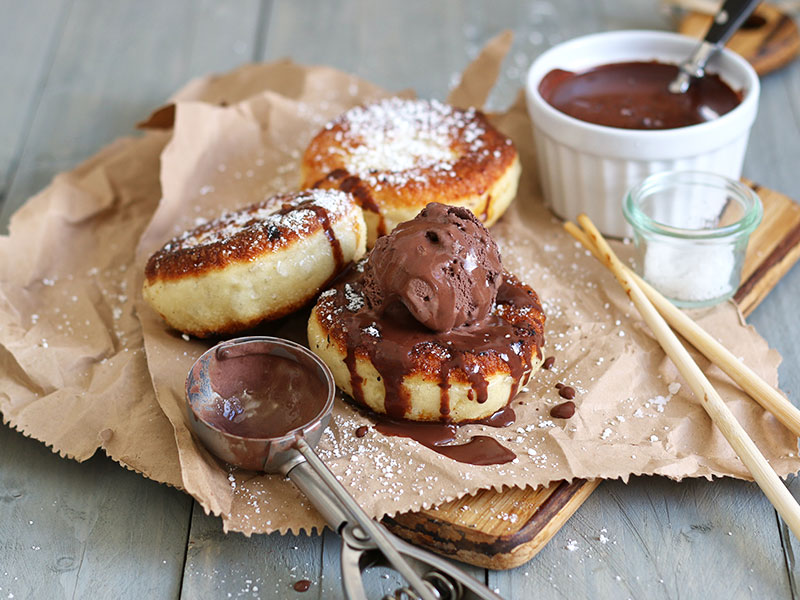
Well…. and if you’re looking for something sweet from Korea, we recommend our delicious Hotteok. These thick pancakes are a popular street food dish in Asia – and not just in Korea.
INGREDIENTS / ZUTATEN
(2 servings)
some toasted sesame oil* or neutral oil for frying
1 large red onion, cut into fine wedges
2-3 garlic cloves, finely chopped
1-2 tbsp. Gochujang*
1-2 tbsp. Gochugaru*
1 tbsp. soy sauce*
1 tsp. sugar
2 cups (500ml) warm water
17.6 oz. (500g) rice cakes (sticks)*
3-4 spring onions, cut into small pieces (approx. 2cm long)
some spring onion rings for decoration
some black sesame seeds for decoration
2 boiled eggs, halved (optional)
(2 Portionen)
etwas geröstetes Sesamöl* oder neutrales Öl zum Anbraten
1 große rote Zwiebel, in feine Spalten geschnitten
2-3 Knoblauchzehen, fein gehackt
1-2 EL Gochujang*
1-2 EL Gochugaru*
1 EL Sojasoße*
1 TL Zucker
500ml warmes Wasser
500g Reiskuchen (Sticks)*
3-4 Frühlingszwiebeln, in kleinen Stücken (etwa 2cm)
einige Frühlingszwiebelringe für die Dekoration
etwas schwarzer Sesam für die Dekoration
2 gekochte Eier, halbiert (optional)
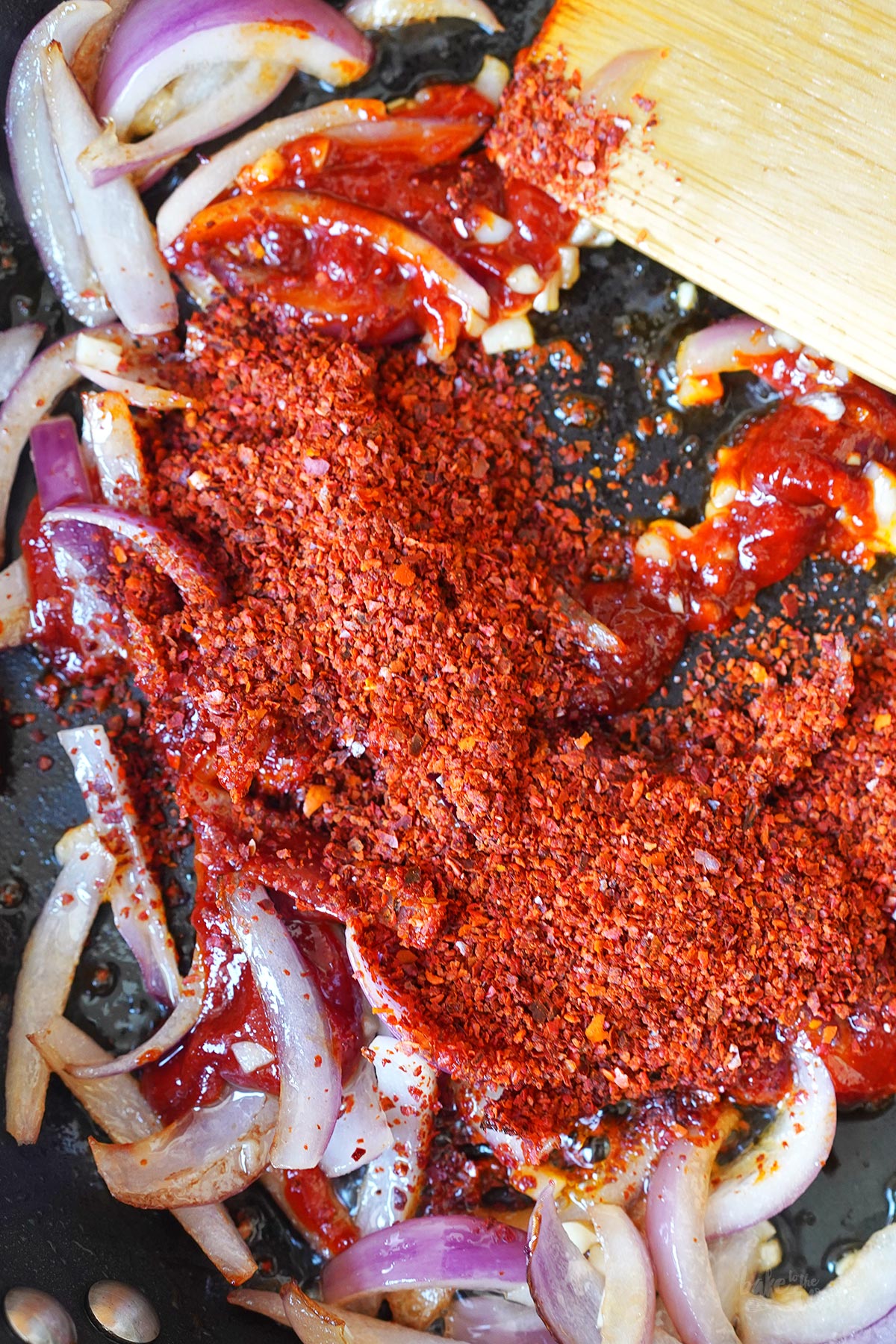
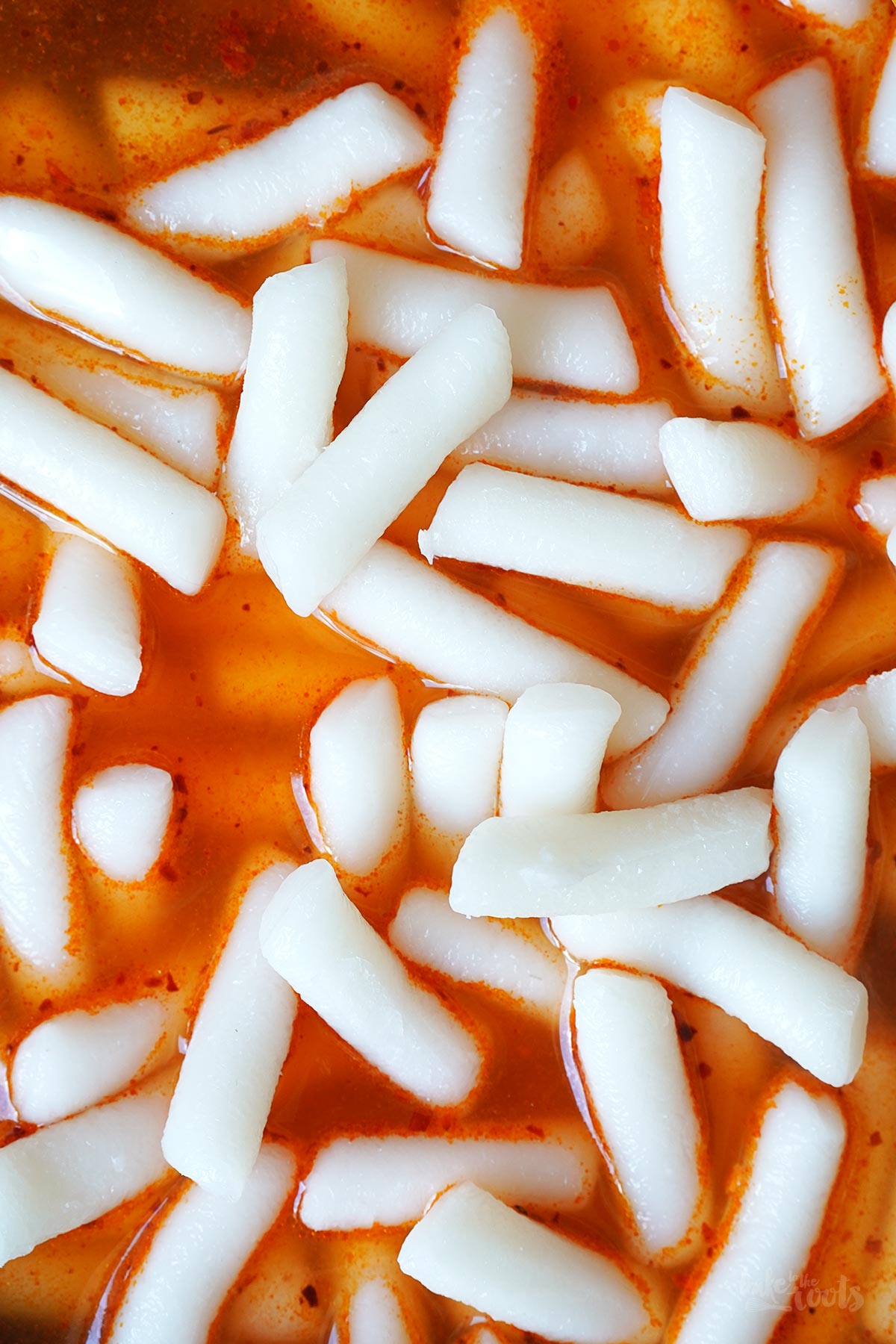
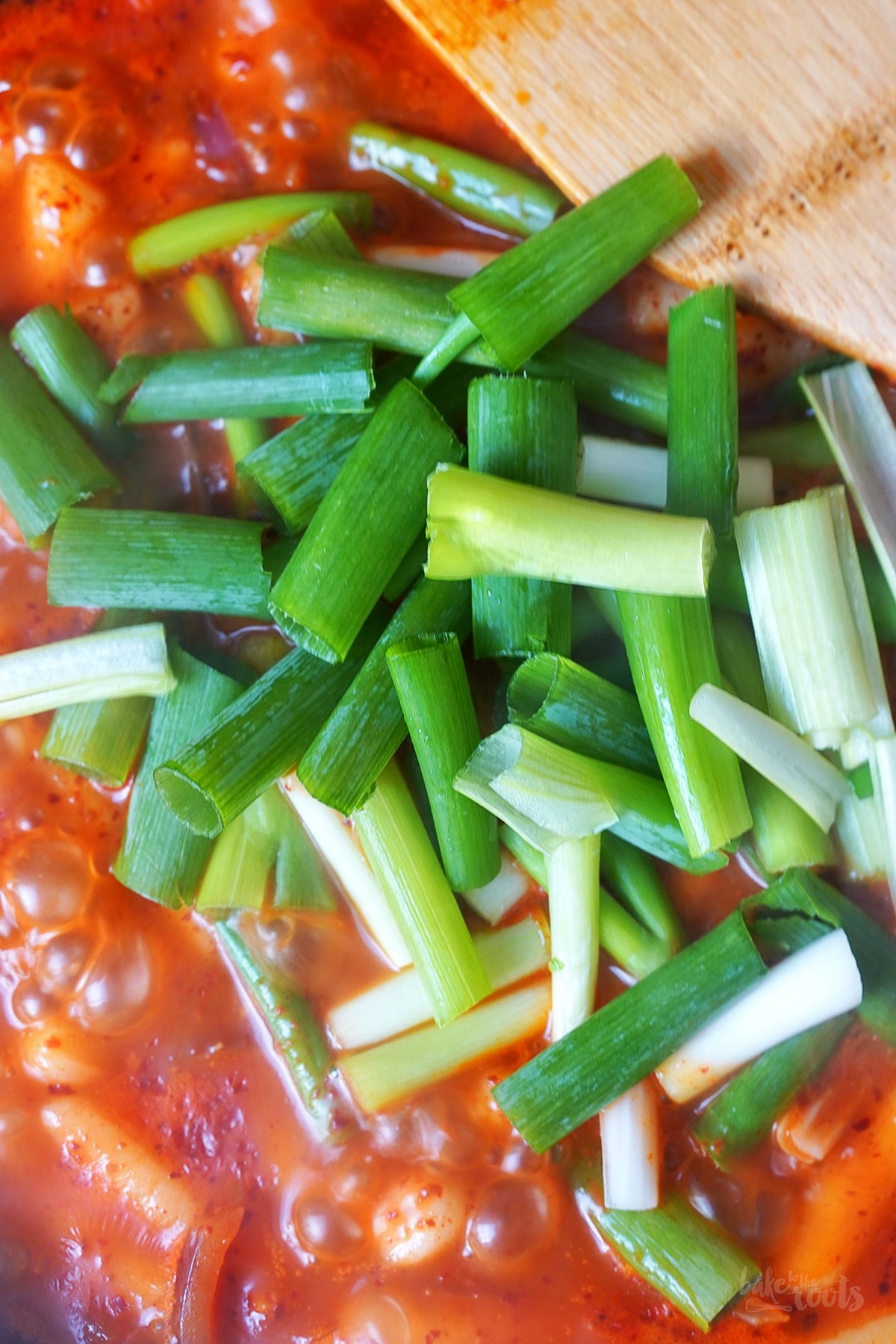
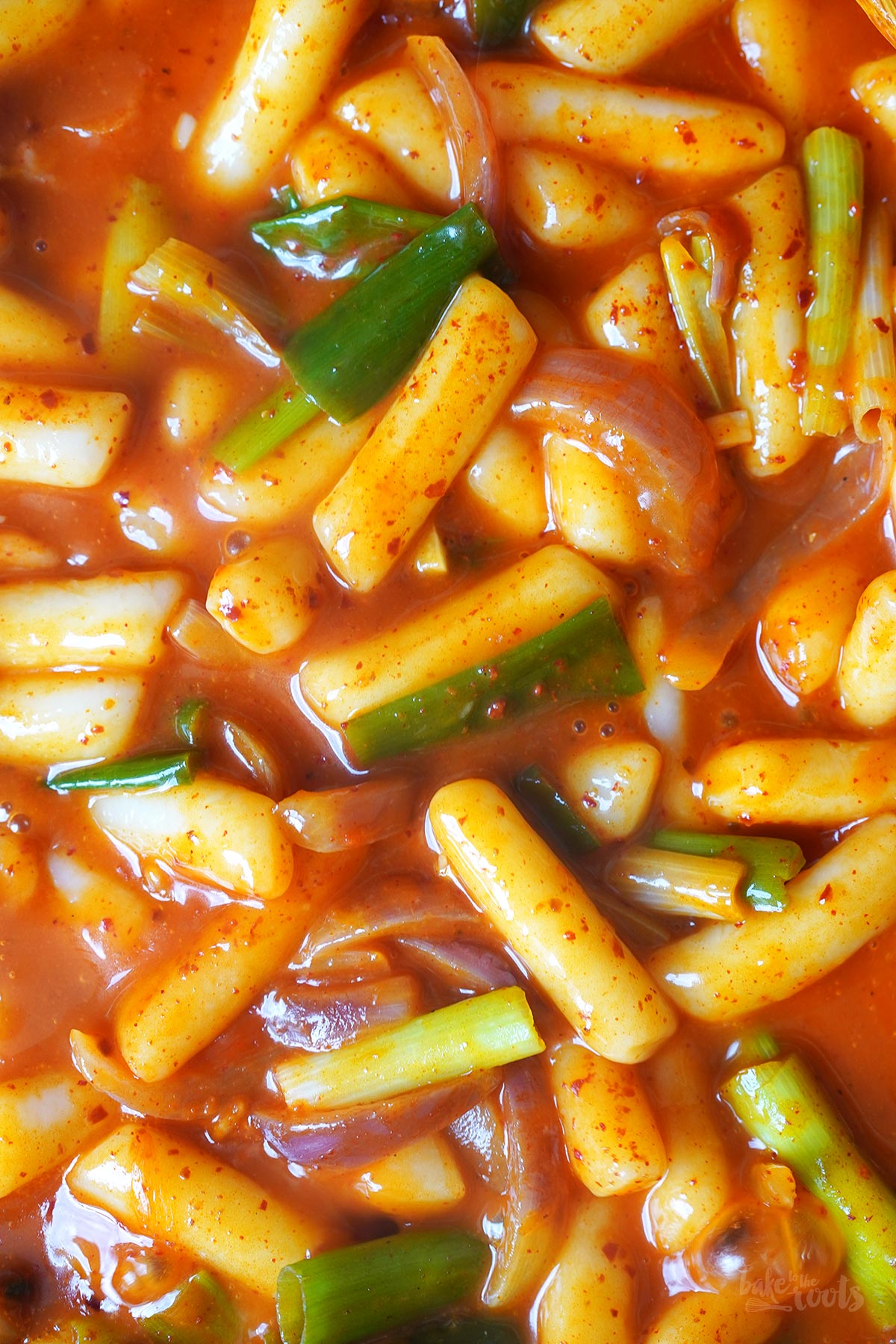
DIRECTIONS / ZUBEREITUNG
1. Peel the onion and garlic and cut into thin slices or chop finely. Wash and dry the spring onions and cut them into 2 cm long pieces. Set aside.
2. Heat some oil in a large frying pan. Add the onion and sauté briefly, then add the garlic and sauté as well – you want the onions to be a bit softer, but avoid browning.
3. Next, add the Gochujang, Gochugaru, soy sauce, and sugar. Mix well and let everything cook for a moment. The chili paste and chili flakes together can be quite spicy – if you can’t tolerate a lot of heat, you should season with smaller amounts only. You can always add more later. Deglaze everything with the water, then add the rice cakes and bring everything to a boil. Let the rice cakes simmer (over slightly reduced heat) for about 5 minutes, stirring occasionally. The sauce should start to thicken a little at this point. Next, add the spring onion pieces and let everything simmer for another 5 minutes until the rice cakes are soft, and the sauce is nice and thick.
4. Spoon the Tteokbokki into bowls or onto plates and serve with some additional spring onion rings, black sesame seeds, and boiled eggs (optional) to your liking. We love to serve the rice cakes with some Korean Cucumber Salad.
1. Die Zwiebel und den Knoblauch schälen und dann in feine Spalten schneiden bzw. fein hacken. Die Frühlingszwiebeln waschen, trocknen und dann in etwa 2cm lange Stücke schneiden. Zur Seite stellen.
2. Eine große Pfanne mit etwas Öl erhitzen. Die Zwiebelspalten dazugeben und kurz anschwitzen, dann den Knoblauch dazugeben und ebenfalls kurz anschwitzen lassen – die Zwiebeln dürfen etwas weicher geworden sein, sollten aber nicht viel Farbe bekommen.
3. Gochujang, Gochugaru, Sojasoße und Zucker in die Pfanne dazugeben, alles gut vermengen und kurz anrösten lassen. Chilipaste und Flocken zusammen können recht scharf werden – wer hier nicht viel verträgt, sollte eher mit kleineren Mengen würzen. Hinterher kann man immer noch etwas nachlegen. Alles mit dem Wasser ablöschen, dann die Reiskuchen dazugeben und alles einmal aufkochen lassen. Die Reiskuchen dann bei leicht reduzierter Hitzezufuhr unter gelegentlichem umrühren für etwa 5 Minuten köcheln lassen. Die Soße sollte hier schon ein wenig andicken. Als Nächstes die Frühlingszwiebelstücke dazugeben und alles noch einmal 5 Minuten köcheln lassen, bis die Reiskuchen weich sind und die Soße schön dickflüssig ist.
4. Die Tteokbokki auf Schüsseln oder Teller aufteilen, nach Belieben mit zusätzlichen Frühlingszwiebelringen, schwarzem Sesam und gekochten Eiern (optional) servieren. Dazu passt z.B. ein koreanischer Gurkensalat.
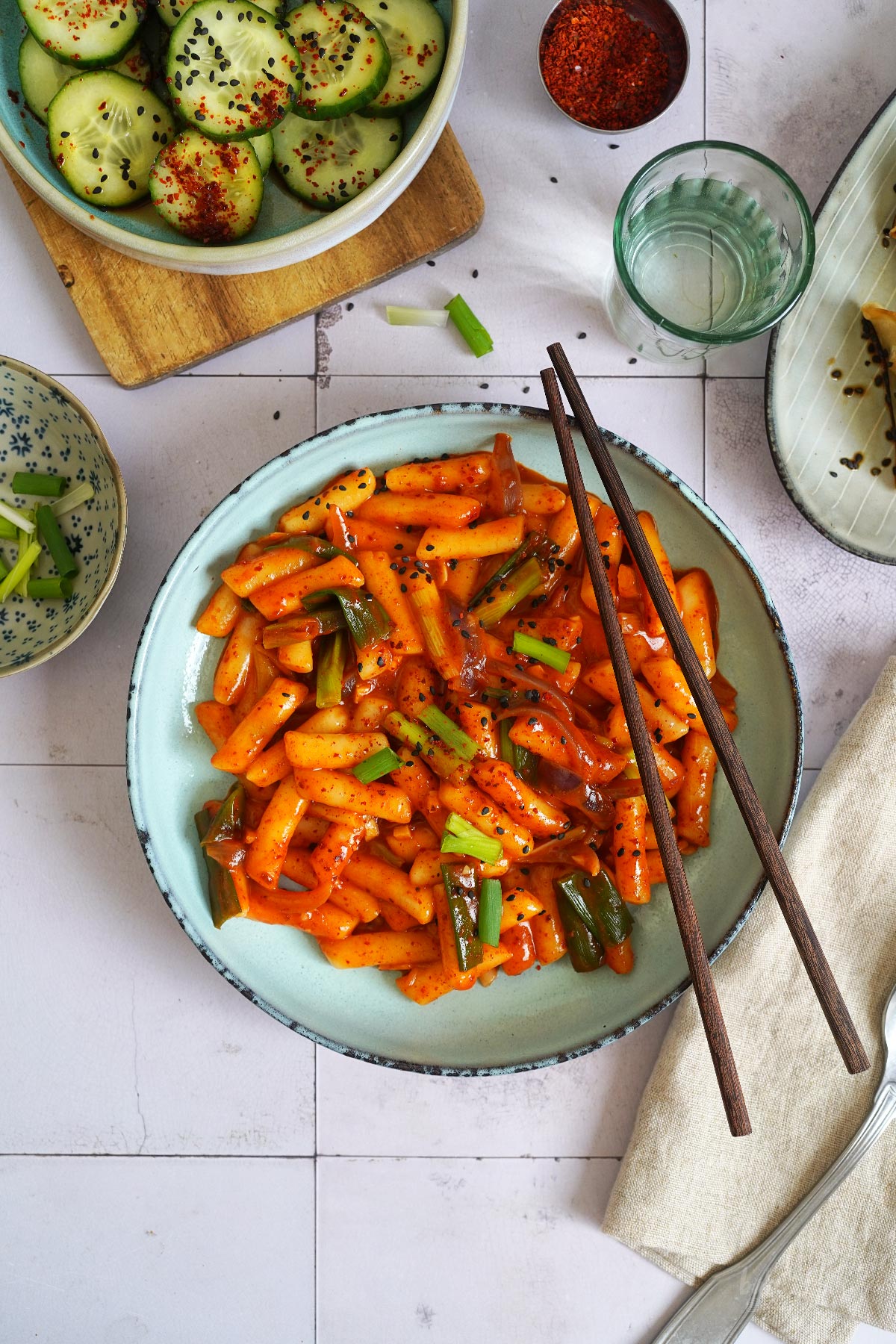
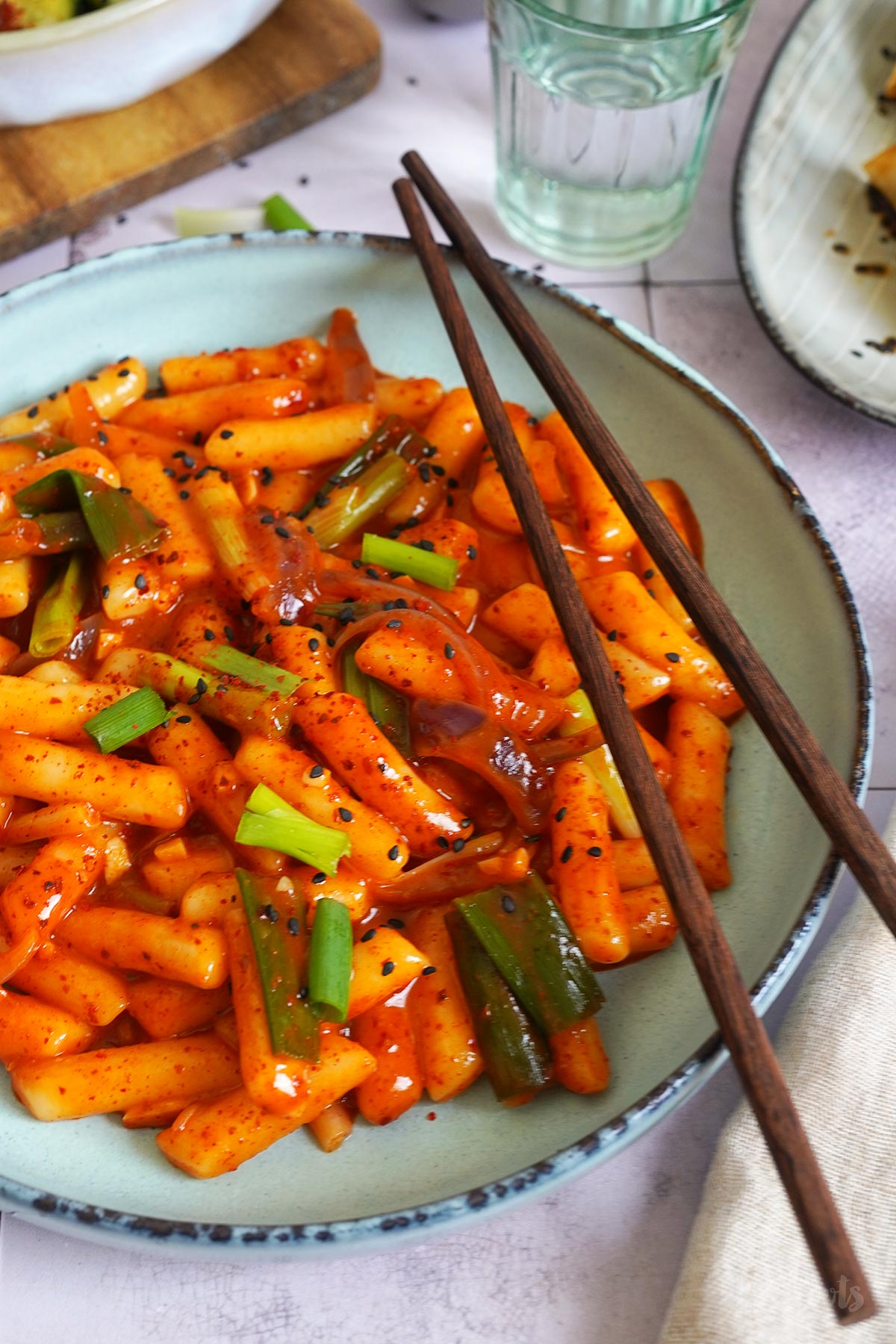
Craving more? Keep in touch on Facebook, Instagram and Pinterest for new post updates and more. You can also contact me with any questions or inquiries!
Here is a version of the recipe you can print easily.
Print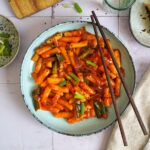
Korean Tteokbokki with Gochujang
- Prep Time: 00:10
- Cook Time: 00:10
- Total Time: 00:20
- Yield: 2 1x
- Category: Dinner
- Cuisine: Korea
- Diet: Vegetarian
Description
Korean Tteokbokki are a tasty dish that can be prepared in no time – if you make them with Gochujang sauce, they pack quite a bit of heat ;P
Ingredients
some toasted sesame oil* or neutral oil for frying
1 large red onion, cut into fine wedges
2-3 garlic cloves, finely chopped
1-2 tbsp. Gochujang*
1-2 tbsp. Gochugaru*
1 tbsp. soy sauce*
1 tsp. sugar
2 cups (500ml) warm water
17.6 oz. (500g) rice cakes (sticks)*
3-4 spring onions, cut into small pieces (approx. 2cm long)
some spring onion rings for decoration
some black sesame seeds for decoration
2 boiled eggs, halved (optional)
Instructions
1. Peel the onion and garlic and cut into thin slices or chop finely. Wash and dry the spring onions and cut them into 2 cm long pieces. Set aside.
2. Heat some oil in a large frying pan. Add the onion and sauté briefly, then add the garlic and sauté as well – you want the onions to be a bit softer, but avoid browning.
3. Next, add the Gochujang, Gochugaru, soy sauce, and sugar. Mix well and let everything cook for a moment. The chili paste and chili flakes together can be quite spicy – if you can’t tolerate a lot of heat, you should season with smaller amounts only. You can always add more later. Deglaze everything with the water, then add the rice cakes and bring everything to a boil. Let the rice cakes simmer (over slightly reduced heat) for about 5 minutes, stirring occasionally. The sauce should start to thicken a little at this point. Next, add the spring onion pieces and let everything simmer for another 5 minutes until the rice cakes are soft, and the sauce is nice and thick.
4. Spoon the Tteokbokki into bowls or onto plates and serve with some additional spring onion rings, black sesame seeds, and boiled eggs (optional) to your liking. We love to serve the rice cakes with some Korean Cucumber Salad.
Notes
Make something amazing in the kitchen!
Links marked with an asterisk (*) are affiliate links (advertising/Werbung) to Amazon Germany. If you click on one of those links and buy something via this link, I will get a commission for that sale. The price of whatever you buy is not affected in any way by this.



